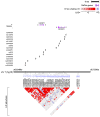IGF-1, IGFBP-1, and IGFBP-3 polymorphisms predict circulating IGF levels but not breast cancer risk: findings from the Breast and Prostate Cancer Cohort Consortium (BPC3)
- PMID: 18596909
- PMCID: PMC2440354
- DOI: 10.1371/journal.pone.0002578
IGF-1, IGFBP-1, and IGFBP-3 polymorphisms predict circulating IGF levels but not breast cancer risk: findings from the Breast and Prostate Cancer Cohort Consortium (BPC3)
Abstract
IGF-1 has been shown to promote proliferation of normal epithelial breast cells, and the IGF pathway has also been linked to mammary carcinogenesis in animal models. We comprehensively examined the association between common genetic variation in the IGF1, IGFBP1, and IGFBP3 genes in relation to circulating IGF-I and IGFBP-3 levels and breast cancer risk within the NCI Breast and Prostate Cancer Cohort Consortium (BPC3). This analysis included 6,912 breast cancer cases and 8,891 matched controls (n = 6,410 for circulating IGF-I and 6,275 for circulating IGFBP-3 analyses) comprised primarily of Caucasian women drawn from six large cohorts. Linkage disequilibrium and haplotype patterns were characterized in the regions surrounding IGF1 and the genes coding for two of its binding proteins, IGFBP1 and IGFBP3. In total, thirty haplotype-tagging single nucleotide polymorphisms (htSNP) were selected to provide high coverage of common haplotypes; the haplotype structure was defined across four haplotype blocks for IGF1 and three for IGFBP1 and IGFBP3. Specific IGF1 SNPs individually accounted for up to 5% change in circulating IGF-I levels and individual IGFBP3 SNPs were associated up to 12% change in circulating IGFBP-3 levels, but no associations were observed between these polymorphisms and breast cancer risk. Logistic regression analyses found no associations between breast cancer and any htSNPs or haplotypes in IGF1, IGFBP1, or IGFBP3. No effect modification was observed in analyses stratified by menopausal status, family history of breast cancer, body mass index, or postmenopausal hormone therapy, or for analyses stratified by stage at diagnosis or hormone receptor status. In summary, the impact of genetic variation in IGF1 and IGFBP3 on circulating IGF levels does not appear to substantially influence breast cancer risk substantially among primarily Caucasian postmenopausal women.
Conflict of interest statement
Figures


Similar articles
-
A comprehensive analysis of common IGF1, IGFBP1 and IGFBP3 genetic variation with prospective IGF-I and IGFBP-3 blood levels and prostate cancer risk among Caucasians.Hum Mol Genet. 2010 Aug 1;19(15):3089-101. doi: 10.1093/hmg/ddq210. Epub 2010 May 19. Hum Mol Genet. 2010. PMID: 20484221 Free PMC article.
-
Haplotype-based association studies of IGFBP1 and IGFBP3 with prostate and breast cancer risk: the multiethnic cohort.Cancer Epidemiol Biomarkers Prev. 2006 Oct;15(10):1993-7. doi: 10.1158/1055-9965.EPI-06-0361. Cancer Epidemiol Biomarkers Prev. 2006. PMID: 17035411
-
IGFBP1 and IGFBP3 polymorphisms predict circulating IGFBP-3 levels among women from high-risk breast cancer families.Breast Cancer Res Treat. 2011 Jun;127(3):785-94. doi: 10.1007/s10549-010-1277-1. Epub 2010 Dec 8. Breast Cancer Res Treat. 2011. PMID: 21140206
-
IGF1(CA)19 and IGFBP-3-202A/C gene polymorphism and cancer risk: a meta-analysis.Cell Biochem Biophys. 2014 May;69(1):169-78. doi: 10.1007/s12013-013-9784-4. Cell Biochem Biophys. 2014. PMID: 24310658
-
A Systematic Review and Meta-Analysis on the Effect of Flavonoids on Insulin-like Growth Factor and Insulin-like Growth Factor Binding Protein and Incidence of Breast Cancer.Curr Med Chem. 2023;30(14):1657-1666. doi: 10.2174/0929867329666220801164740. Curr Med Chem. 2023. PMID: 35927904
Cited by
-
Association between single-nucleotide polymorphisms in growth factor genes and quality of life in men with prostate cancer and the general population.Qual Life Res. 2015 Sep;24(9):2183-93. doi: 10.1007/s11136-015-0950-6. Epub 2015 Feb 28. Qual Life Res. 2015. PMID: 25724697
-
Polymorphisms of Insulin-Like Growth Factor 1 Pathway Genes and Breast Cancer Risk.Front Oncol. 2016 Jun 8;6:136. doi: 10.3389/fonc.2016.00136. eCollection 2016. Front Oncol. 2016. PMID: 27376028 Free PMC article.
-
Clinical significance of insulin-like growth factor gene polymorphisms with survival in patients with gastrointestinal stromal tumors.J Korean Surg Soc. 2012 May;82(5):288-95. doi: 10.4174/jkss.2012.82.5.288. Epub 2012 Apr 26. J Korean Surg Soc. 2012. PMID: 22563535 Free PMC article.
-
Genetic polymorphisms of insulin-like growth factor 1 and insulin-like growth factor binding protein 3, xenoestrogen, phytoestrogen, and premenopausal breast cancer.Curr Oncol. 2016 Feb;23(1):e17-23. doi: 10.3747/co.23.2835. Epub 2016 Feb 18. Curr Oncol. 2016. PMID: 26966408 Free PMC article.
-
IGFBP3 polymorphisms and risk of esophageal cancer in a Chinese population.Int J Clin Exp Med. 2015 Sep 15;8(9):17006-14. eCollection 2015. Int J Clin Exp Med. 2015. PMID: 26629256 Free PMC article.
References
-
- Sachdev D, Yee D. The IGF system and breast cancer. Endocrine Related Cancer. 2001;8:197–209. - PubMed
-
- Wood TL, Yee D. IGFs and IGFBPs in the normal mammary gland and in breast cancer. Journal of Mammary Gland Biology and Neoplasia. 2000;5:1–5. - PubMed
-
- Baxter RC. Insulin-like growth factor binding proteins in the human circulation: a review. Hormone Research. 1994;42:140–144. - PubMed
-
- Burger AM, Leyland-Jones B, Banerjee K, Spyropoulos DD, Seth AK. Essential roles of IGFBP-3 and IGFBP-rP1 in breast cancer. European Journal of Cancer. 2005;41:1515–1527. - PubMed
-
- Hadsell DL, Bonnette SG. IGF and insulin action in the mammary gland: lessons from transgenic and knockout models. Journal of Mammary Gland Biology and Neoplasia. 2000;5:19–30. - PubMed
Publication types
MeSH terms
Substances
Grants and funding
LinkOut - more resources
Full Text Sources
Medical
Miscellaneous

